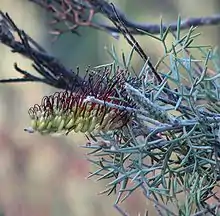Grevillea armigera
Grevillea armigera, also known as prickly toothbrushes or thorny grevillea,[2] is a species of flowering plant in the family Proteaceae and is endemic to the south-west of Western Australia. It is an erect to spreading shrub with deeply-lobed leaves, the lobes linear and sharply pointed, and grey, green or pale yellow flowers with black to maroon styles.
| Prickly toothbrushes | |
|---|---|
 | |
| In Maranoa Gardens | |
| Scientific classification | |
| Kingdom: | Plantae |
| Clade: | Tracheophytes |
| Clade: | Angiosperms |
| Clade: | Eudicots |
| Order: | Proteales |
| Family: | Proteaceae |
| Genus: | Grevillea |
| Species: | G. armigera |
| Binomial name | |
| Grevillea armigera | |
Description
Grevillea armigera is an erect to spreading shrub that typically grows to a height of 0.5–3.5 m (1 ft 8 in – 11 ft 6 in). Its leaves are 25–50 mm (1.0–2.0 in) long and have five to eleven lobes, each usually further divided with three to five lobes, the end lobes linear, sharply-pointed, 2–25 mm (0.08–0.98 in) long and 0.5–1.5 mm (0.02–0.06 in) wide with the edges rolled under. The flowers are arranged along a rachis 50–90 mm (2.0–3.5 in) long, and are grey, green or pale yellow with a black to blackish maroon style. The pistil is 18–23 mm (0.71–0.91 in) long with a more or less sessile ovary. Flowering mainly occurs from June to February and the fruit is a follicle 11.5–14 mm (0.45–0.55 in) long.[2][3]
Taxonomy
Grevillea armigera was first formally described in 1856 by Swiss botanist Carl Meissner in de Candolle's Prodromus Systematis Naturalis Regni Vegetabilis from specimens collected by James Drummond in the Swan River Colony.[4][5] The specific epithet (armigera) means "furnished with thorns".[6]
Distribution and habitat
Prickly toothbrushes grows in heath and shrubland from Buntine to near Dowerin in the Avon Wheatbelt and Geraldton Sandplains biogeographic regions.[2][3]
References
- "Grevillea armigera". Australian Plant Census. Retrieved 1 December 2021.
- "Grevillea armigera". Australian Biological Resources Study, Department of Agriculture, Water and the Environment: Canberra. Retrieved 1 December 2021.
- "Grevillea armigera". FloraBase. Western Australian Government Department of Biodiversity, Conservation and Attractions.
- "Grevillea armigera". APNI. Retrieved 1 December 2020.
- Meissner, Carl (1856). Prodromus systematis naturalis regni vegetabilis. Paris: Victoris Masson. p. 373. Retrieved 1 December 2021.
- Sharr, Francis Aubi; George, Alex (2019). Western Australian Plant Names and Their Meanings (3rd ed.). Kardinya, WA: Four Gables Press. p. 137. ISBN 9780958034180.